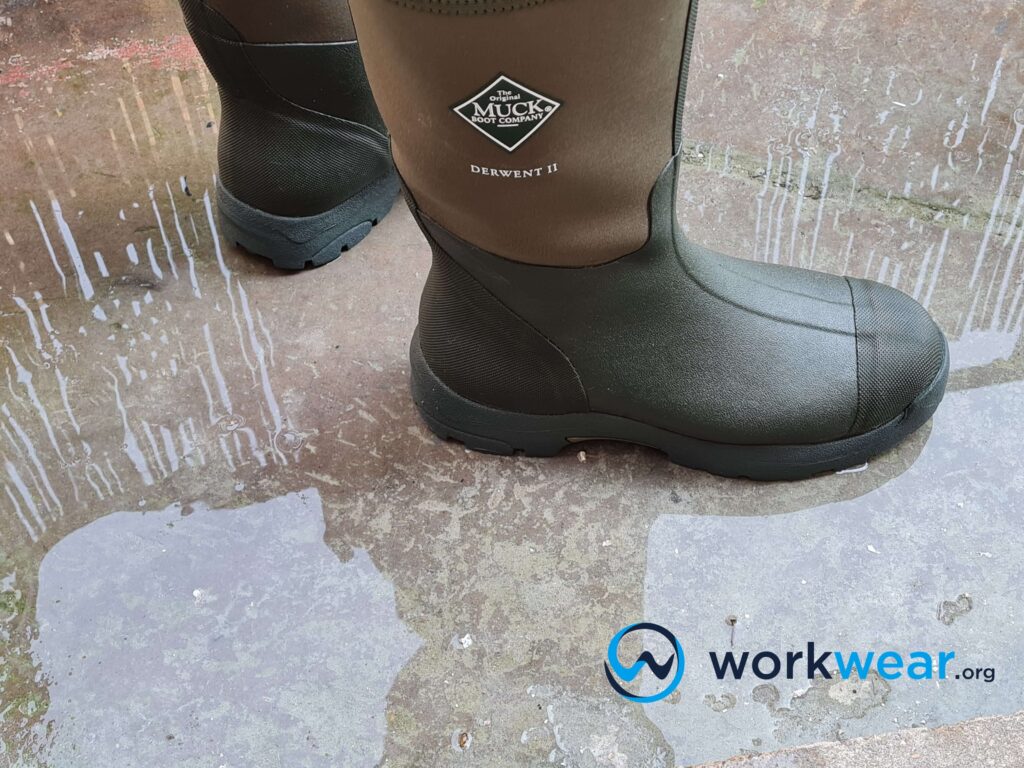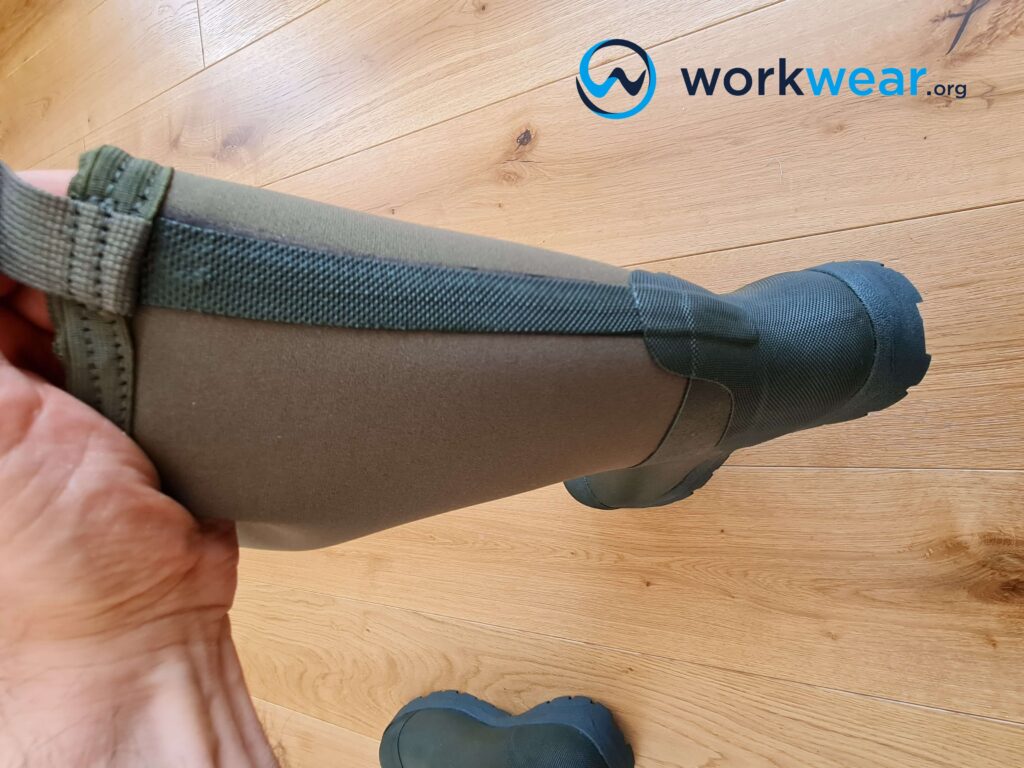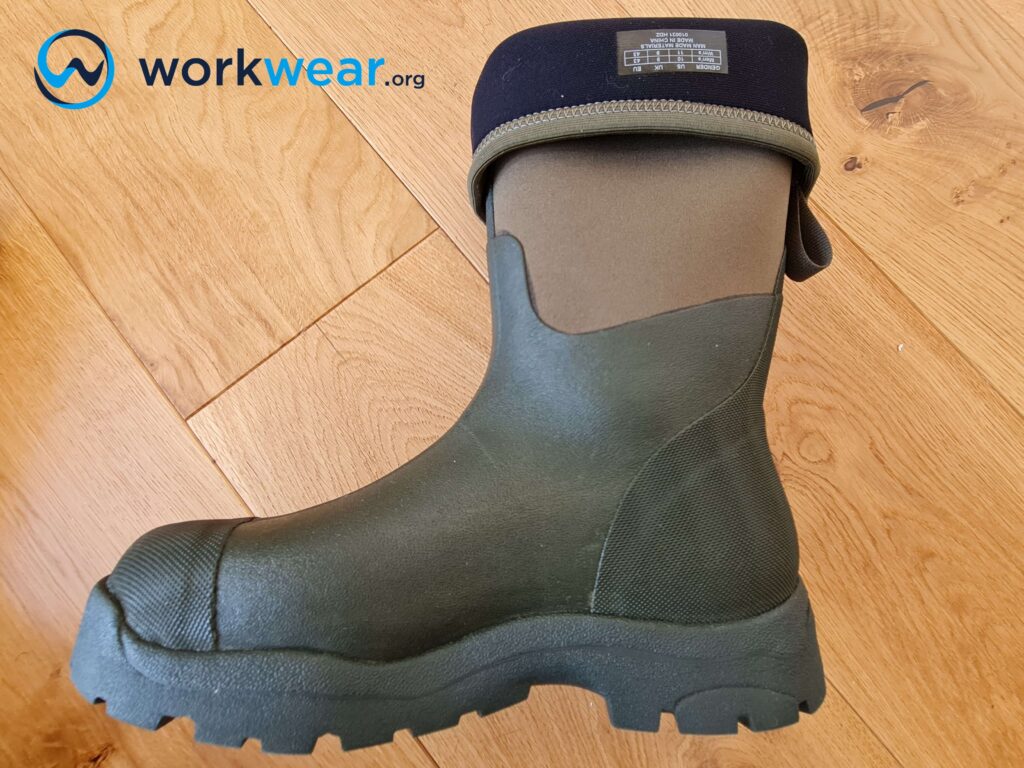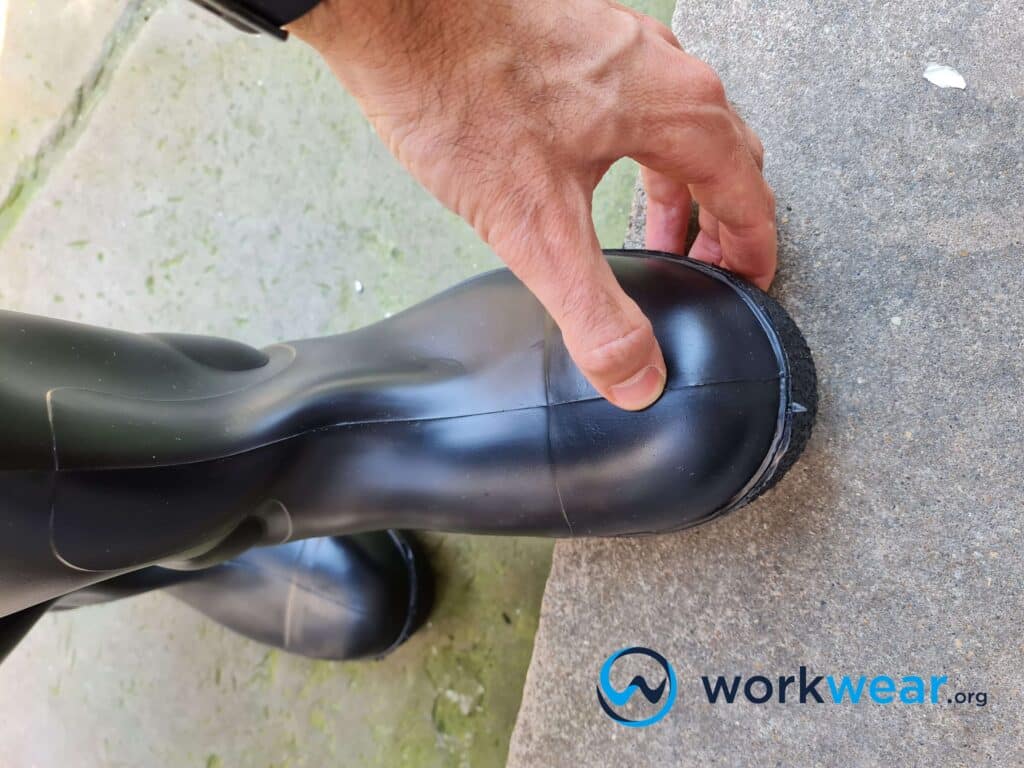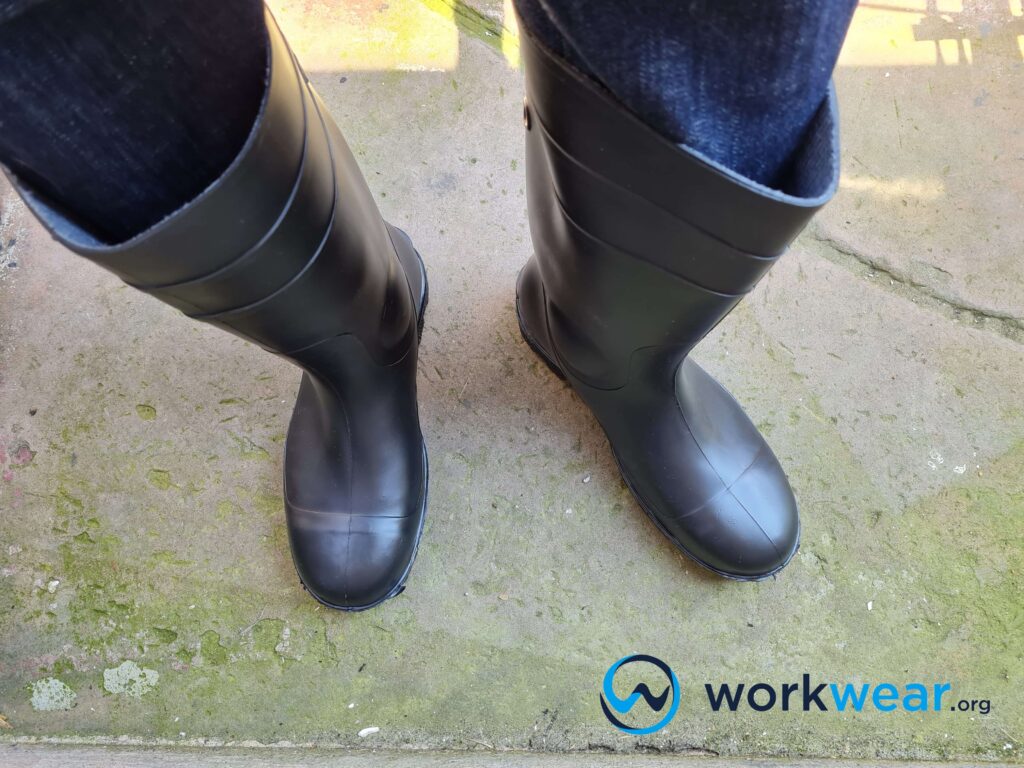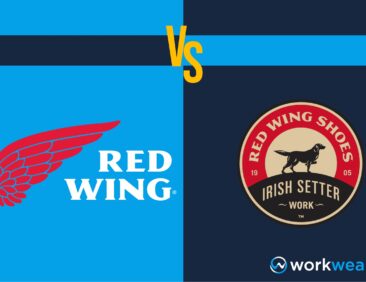PVC VS Neoprene VS Rubber – Which one is superior in work boots?
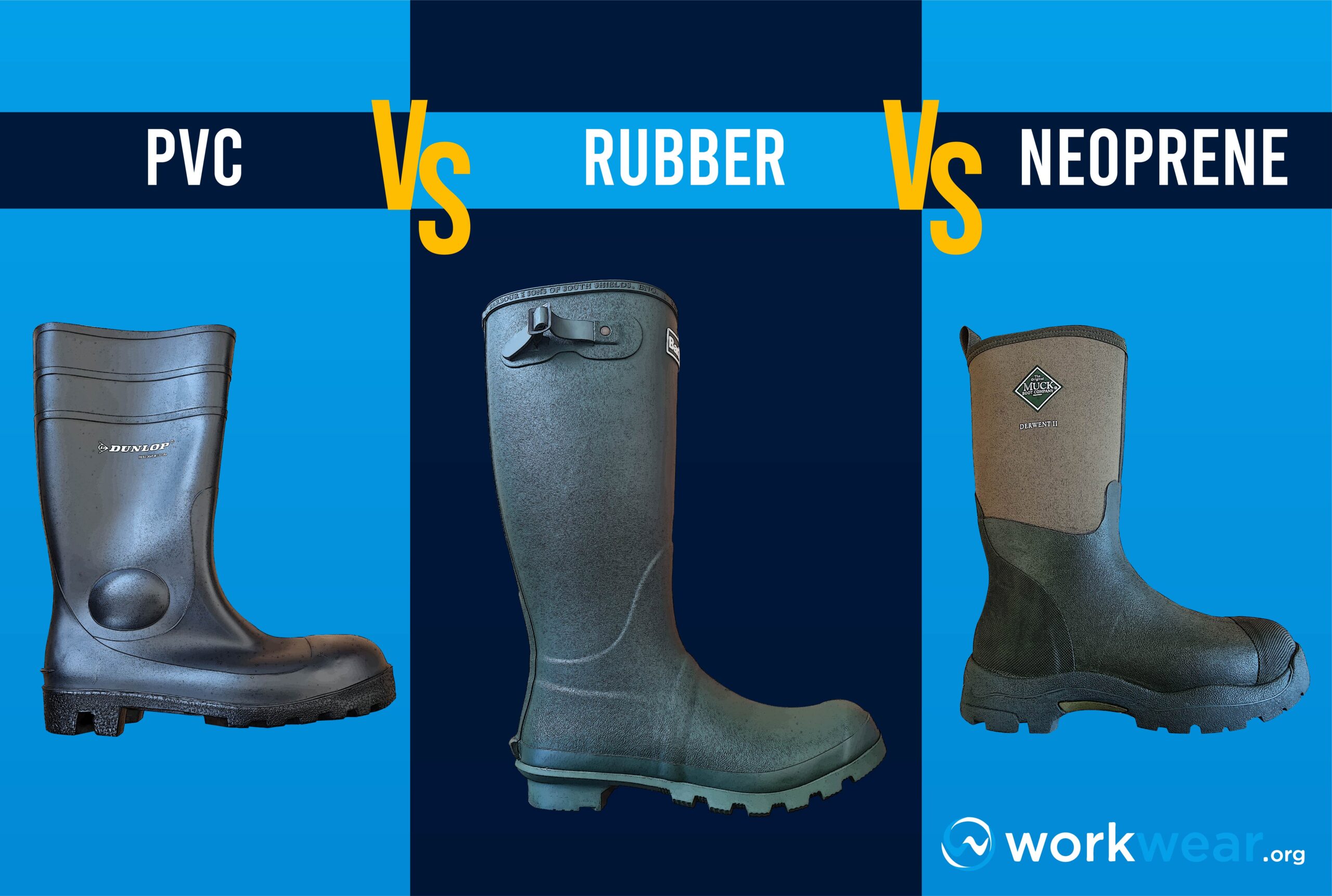
If working outdoors in the rain and other wet conditions can’t be avoided, you must arm yourself with the proper gear. Are you unsure about the type of boots – and which materials – you should get for wet environments? Don’t worry; we have you taken care of. We have tested rubber, PVC, and neoprene boots in various wet settings to check how they would perform. Our experiences fueled the comparisons below, going beyond the boots’ ability to keep the feet dry and deeper into each material’s unique qualities.
Main Similarities
Water Resistance
PVC, rubber, and neoprene are all waterproof. Boots with these materials completely seal out liquids and don’t absorb moisture. They can be used for wading or working in extremely wet conditions since they can dry the feet. Rubber, neoprene, or PVC boots with tall heights are especially helpful in blocking wetness. These tall boots stop liquids from coming in through the top, making walking in deep puddles or muddy ground easier and safer.
Winner: Neoprene, rubber, and PVC are all winners when it comes to water resistance because they’re all waterproof. Boots made with these materials can be relied on to keep the feet dry, even in severely wet environments.
Chemical Protection
Aside from water, other substances need to be sealed out in wet conditions. PVC and rubber typically offer some level of chemical protection to protect the feet from coming in contact with harmful substances. PVC can stop oils, animal fats, and other chemicals from being absorbed so that the skin won’t get irritated or harmed by accidental exposure. PVC boots provide the coverage workers need to keep their feet safe while working in conditions with hazardous substances around them. Meanwhile, rubber boots strongly resist ammonia, animal waste, and fertilizers – but they can absorb or degrade when exposed to certain oils. Work boots with neoprene uppers offer good resistance to mild acids but don’t hold up as strongly as PVC in harsher substances.
Winner: PVC wins in chemical protection. PVC boots are highly resistant to chemicals, oils, and acids, so they’re better suited for industrial applications than neoprene or rubber boots.
Main Differences
Flexibility
Flexible boots affect not only comfort but also mobility on the job. Neoprene is an exceptionally flexible material that offers a host of other benefits. It fits like a glove and follows the shape of the feet and calves. Neoprene boots provide a personalized fit with flexibility, making movements almost effortless while protecting the feet against the elements. The material can stretch as the foot enters and then molds itself to the contours of the feet, ankles, and calves for superior comfort. Rubber boots can also be flexible, especially compared to some types of leather. The flexibility largely depends on the thickness of the rubber used to build the boots. Rubber boots allow the feet to move freely and typically have spacious designs. However, they’re not as flexible and comfortable as neoprene boots that instantly follow the shape of the feet.
Meanwhile, PVC boots have stiffer structures than the previous two materials discussed. They don’t flex as easily as neoprene and rubber, so that these boots can restrict some of the motion of the feet and ankles.
Winner: Neoprene is the clear winner regarding flexibility. It stretches and returns to its original shape as needed, creating a personalized fit that enhances comfort and mobility.
Insulation
Wet work conditions often come with extreme temperatures as well. Neoprene work boots are suited for these settings because of their insulation properties. Neoprene traps warmth within the boots, keeping the feet comfortable when working in cold environments. Its ability to closely follow the contours of the feet and calves contributes to much-needed heat retention to fight the cold.
Rubber is also a good heat insulator. It can trap some heat, but not at the level of neoprene’s temperature regulation. Rubber boots won’t protect the feet from feeling frozen, especially with spacious boot styles that can easily allow cold air in. PVC boots, on the other hand, can offer minimal protection in uncomfortably low temperatures. They don’t insulate the feet from a frozen feeling, making them unsuitable for cold work conditions.
Winner: Neoprene outshines the other options for insulation. It’s a great insulator that retains enough heat to keep the feet warm and comfortable all day in cold conditions.
Weight
Tall boots with waterproof designs come in varying weight levels. PVC and neoprene typically have relatively lightweight structures, considering their extended heights. Boots made with these materials are ideal for jobs that require being upright or walking for long hours since they don’t drag on the feet with excessive weight. They can also be carried around more easily because they weigh less, so it’s not that difficult to access them when needed.
Rubber boots, in general, tend to have heavy styles. The ones with extra-thick structures are particularly weighty, resulting in significant discomfort when used for hours of walking or standing. The bulky designs of most rubber work boots make them unsuitable for jobs requiring being on your feet for prolonged periods.
Winner: Neoprene and PVC boots are winners with their lightweight structures. They typically don’t cause discomfort even when used for long periods of walking or standing. It’s worth noting that the boots’ weight is also affected by other components, such as buckles or large logos.
Durability
The durability of waterproof boots mainly depends on their materials. Rubber is one of the most hard-wearing materials used for work footwear. It’s highly resistant to wear and tear, especially if the boots undergo a vulcanization process for reinforced strength. Thick rubber boots don’t get torn or worn away that easily, even with exposure to abrasion or harsh substances. They can tough it out in challenging work settings while protecting their feet against the elements.
PVC and neoprene are strong but not as durable as rubber. They’re more prone to tears and other signs of damage, with structures typically thinner than rubber. Neoprene and PVC boots are better suited to less hazardous or demanding settings that won’t break down as easily.
Winner: Rubber boots outperform PVC and neoprene boot options. Rubber is exceptionally tough and can withstand being used in challenging conditions while protecting the feet against wetness.
Material Composition (Natural or Synthetic)
Neoprene and PVC are synthetic materials. Neoprene is a brand name the DuPont Corporation uses for the material polychloroprene. It’s commonly used as a rubber substitute because it shares similar qualities. Meanwhile, PVC (Polyvinyl chloride) is a plastic polymer but is more durable than ordinary plastic.
On the other hand, rubber is a natural material. It’s sourced from the sap of a plant, which is then manufactured to create tough, waterproof products. Certain rubber work boots can undergo a special vulcanization process to strengthen their resistance to wetness further.
Winner: Rubber is the superior choice for those who prefer natural materials for their work boots. The material comes from a natural source, unlike neoprene and PVC, which have synthetic components.
Comparison Table
| PVC | Neoprene | Rubber | |
| Water Resistance | Waterproof | Waterproof | Waterproof |
| Chemical Protection | Strong | Strong | Strong |
| Flexibility | Stiff | Very flexible | Flexible |
| Insulation | Very good | Good | Minimal |
| Weight | Lightweight | Lightweight | Heavy |
| Durability | Good | Good | Outstanding |
| Material Composition | Synthetic | Synthetic | Natural |
Who’s the Overall Winner?
Two materials stand out in this comparison. When it comes to performance, neoprene excels in comfort, namely flexibility, weight, and insulation. Boots made with this material are typically more comfortable for long periods. On the other hand, naturally sourced rubber outperforms the other two materials regarding durability, which is necessary in demanding work conditions.
Recap
Choose PVC work boots for:
- Wet work conditions
- Affordable waterproof boots
- Less weighty work boots
Go for rubber work boots if you:
- Work in harsh conditions
- Want boots made with natural materials
- Need to keep your feet dry in wet settings
Pick neoprene work boots to:
- Keep the feet warm and comfortable in cold, wet environments
- Help the feet move more freely
- Walk comfortably for hours
Personal Testing Experience
We had the chance to test three high-quality boots made with different waterproof materials. The Muck Boot Derwent II Wellington Boot had a neoprene upper that followed the shape of the feet and calves for personalized comfort. This waterproof neoprene layer stopped liquid absorption, so the feet stayed dry in wet conditions. This material made the boot easy to pull on and off, even if it was tall. The robust outsole had a strong grip on most surfaces and prevented slipping. The boot ran a bit large, though, so it can sometimes feel unstable. The Dunlop Protomastor Full Safety Boot had a PVC structure that sealed out water and other liquids to protect against uncomfortable wetness. It had steel toe caps guarding the toes against dangerous impact and compression and a steel midsole to block puncture hazards from the bottom. The boot was roomy enough to welcome wide feet, although the sole felt too thin. Finally, the Barbour Bede Wellington Boot showcased a vulcanized rubber body that completely stopped wet elements from entering, maintaining a dry boot interior in wet surroundings. Its flexible design enabled comfortable walking and didn’t hinder the foot’s natural movement. However, the sole didn’t have a robust feel and wore down easily.
Conclusion
Waterproof work boots are made with different materials, offering their advantages. Neoprene is used to build waterproof work boots that are flexible and lightweight, offering good insulation to maintain a comfortable feel even in low-temperature settings. On the other hand, rubber is preferred for its superior strength and durability, making it a great option for tough work conditions. PVC also has a lightweight structure but is weaker than rubber and stiffer than the other two materials.
FAQ's
- Can all neoprene boots keep the feet warm in cold conditions?
- Yes, neoprene boots can keep the feet comfortably warm in cold settings. However, additional insulating materials may be needed for extremely low temperatures to protect the feet from freezing.
- Which material in this list is the most affordable?
- Typically, PVC boots have the lowest price points compared to natural rubber and branded neoprene options.
- Are rubber, PVC, or neoprene boots suitable for hazardous work areas?
- The ones that have safety features are ideal for hazardous conditions. Safety enhancements such as safety toe caps and puncture-resistant midsoles provide the protection needed to keep the feet safe against hazards in the workplace.
- Do all tall, waterproof boots feel uncomfortably heavy?
- Not all. Some rubber, PVC, or neoprene boots have relatively lightweight designs, especially if the materials are thick enough.
